Tim Hortons in China: A Macroeconomic Analysis of Market Viability
VerifiedAdded on 2023/04/25
|9
|2356
|134
Report
AI Summary
This report assesses the feasibility of Tim Hortons expanding its operations into the Chinese market by examining key macroeconomic indicators such as GDP growth, inflation, unemployment rates, and exchange rates. The analysis reveals that China's large market size, driven by a substantial working population and high consumption rate, presents a significant opportunity. Despite challenges like relatively high borrowing costs and political protectionism, China's stable inflation rate, expanding economy, and increasing purchasing power parity make it an attractive market. The report suggests Tim Hortons should initially focus on Hong Kong to assess the fast-food industry climate before broader expansion, emphasizing competitive pricing, enhanced services like Wi-Fi, and diverse payment options to succeed in the Chinese market.
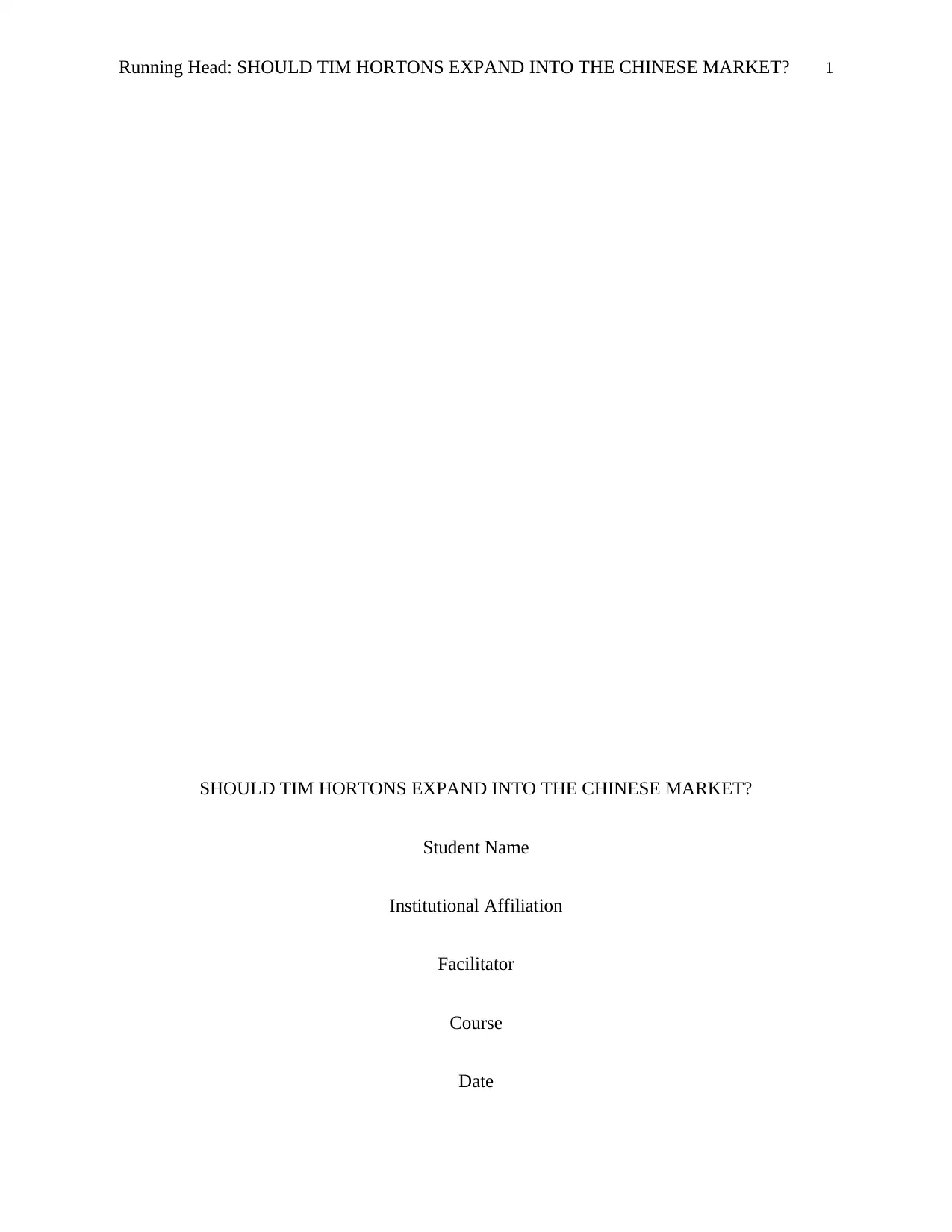
Running Head: SHOULD TIM HORTONS EXPAND INTO THE CHINESE MARKET? 1
SHOULD TIM HORTONS EXPAND INTO THE CHINESE MARKET?
Student Name
Institutional Affiliation
Facilitator
Course
Date
SHOULD TIM HORTONS EXPAND INTO THE CHINESE MARKET?
Student Name
Institutional Affiliation
Facilitator
Course
Date
Paraphrase This Document
Need a fresh take? Get an instant paraphrase of this document with our AI Paraphraser
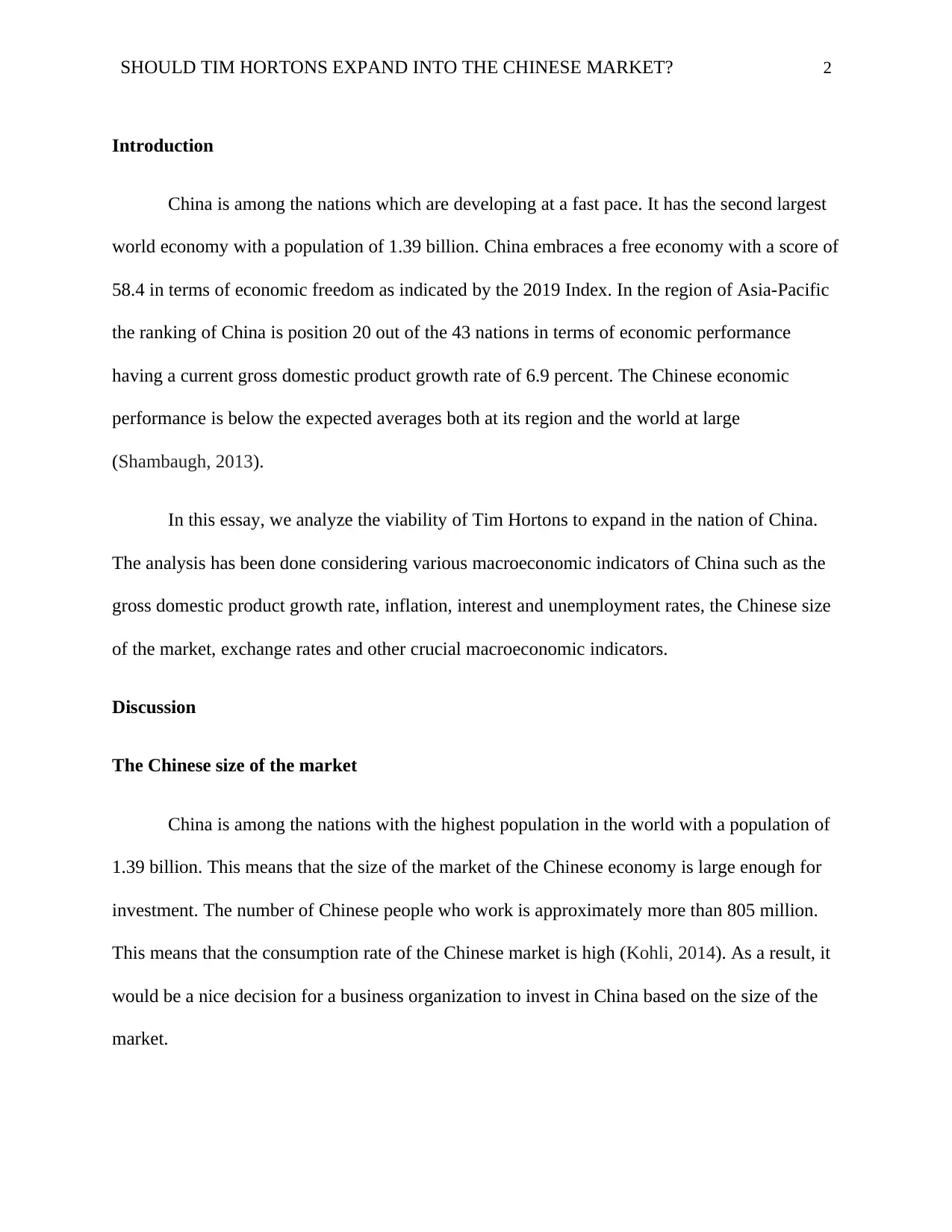
SHOULD TIM HORTONS EXPAND INTO THE CHINESE MARKET? 2
Introduction
China is among the nations which are developing at a fast pace. It has the second largest
world economy with a population of 1.39 billion. China embraces a free economy with a score of
58.4 in terms of economic freedom as indicated by the 2019 Index. In the region of Asia-Pacific
the ranking of China is position 20 out of the 43 nations in terms of economic performance
having a current gross domestic product growth rate of 6.9 percent. The Chinese economic
performance is below the expected averages both at its region and the world at large
(Shambaugh, 2013).
In this essay, we analyze the viability of Tim Hortons to expand in the nation of China.
The analysis has been done considering various macroeconomic indicators of China such as the
gross domestic product growth rate, inflation, interest and unemployment rates, the Chinese size
of the market, exchange rates and other crucial macroeconomic indicators.
Discussion
The Chinese size of the market
China is among the nations with the highest population in the world with a population of
1.39 billion. This means that the size of the market of the Chinese economy is large enough for
investment. The number of Chinese people who work is approximately more than 805 million.
This means that the consumption rate of the Chinese market is high (Kohli, 2014). As a result, it
would be a nice decision for a business organization to invest in China based on the size of the
market.
Introduction
China is among the nations which are developing at a fast pace. It has the second largest
world economy with a population of 1.39 billion. China embraces a free economy with a score of
58.4 in terms of economic freedom as indicated by the 2019 Index. In the region of Asia-Pacific
the ranking of China is position 20 out of the 43 nations in terms of economic performance
having a current gross domestic product growth rate of 6.9 percent. The Chinese economic
performance is below the expected averages both at its region and the world at large
(Shambaugh, 2013).
In this essay, we analyze the viability of Tim Hortons to expand in the nation of China.
The analysis has been done considering various macroeconomic indicators of China such as the
gross domestic product growth rate, inflation, interest and unemployment rates, the Chinese size
of the market, exchange rates and other crucial macroeconomic indicators.
Discussion
The Chinese size of the market
China is among the nations with the highest population in the world with a population of
1.39 billion. This means that the size of the market of the Chinese economy is large enough for
investment. The number of Chinese people who work is approximately more than 805 million.
This means that the consumption rate of the Chinese market is high (Kohli, 2014). As a result, it
would be a nice decision for a business organization to invest in China based on the size of the
market.
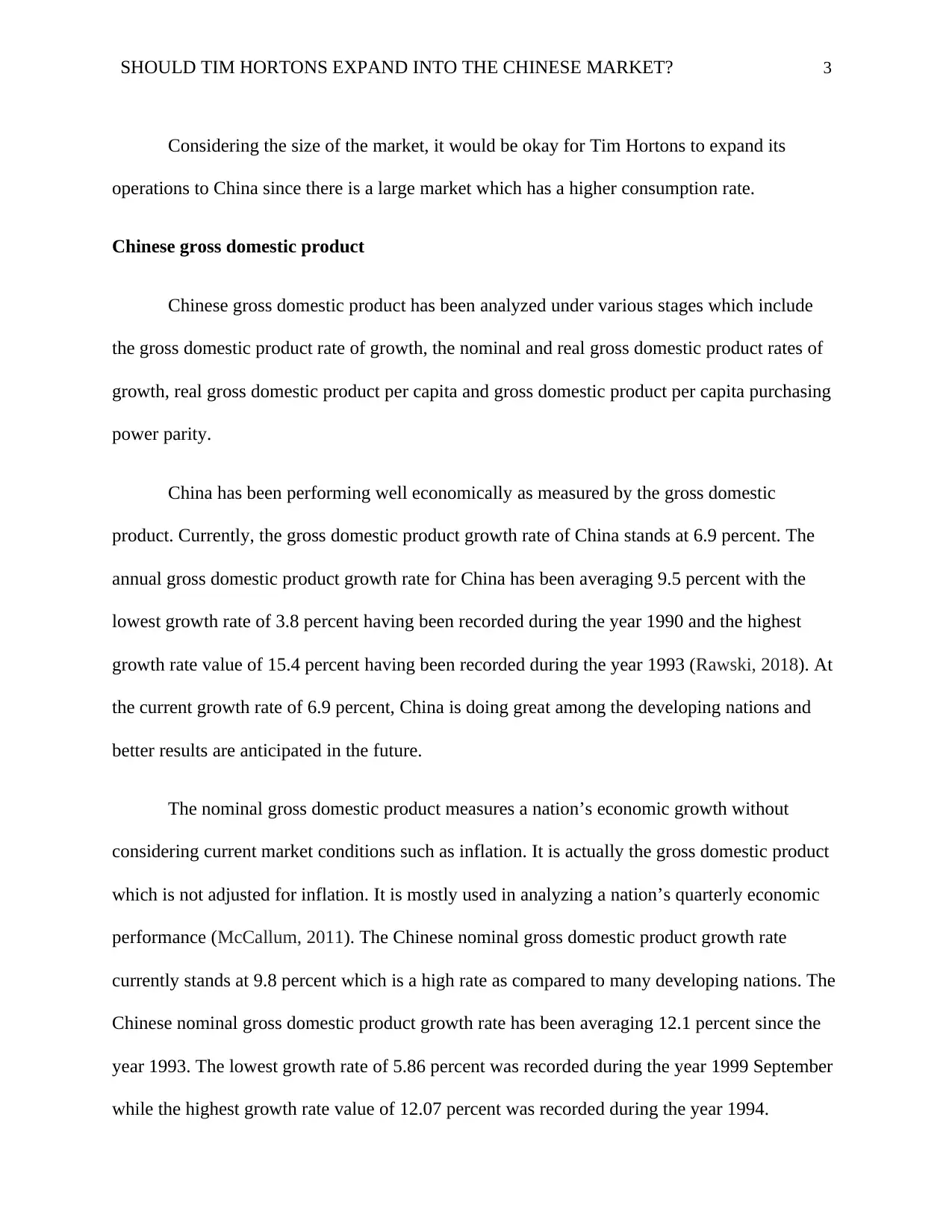
SHOULD TIM HORTONS EXPAND INTO THE CHINESE MARKET? 3
Considering the size of the market, it would be okay for Tim Hortons to expand its
operations to China since there is a large market which has a higher consumption rate.
Chinese gross domestic product
Chinese gross domestic product has been analyzed under various stages which include
the gross domestic product rate of growth, the nominal and real gross domestic product rates of
growth, real gross domestic product per capita and gross domestic product per capita purchasing
power parity.
China has been performing well economically as measured by the gross domestic
product. Currently, the gross domestic product growth rate of China stands at 6.9 percent. The
annual gross domestic product growth rate for China has been averaging 9.5 percent with the
lowest growth rate of 3.8 percent having been recorded during the year 1990 and the highest
growth rate value of 15.4 percent having been recorded during the year 1993 (Rawski, 2018). At
the current growth rate of 6.9 percent, China is doing great among the developing nations and
better results are anticipated in the future.
The nominal gross domestic product measures a nation’s economic growth without
considering current market conditions such as inflation. It is actually the gross domestic product
which is not adjusted for inflation. It is mostly used in analyzing a nation’s quarterly economic
performance (McCallum, 2011). The Chinese nominal gross domestic product growth rate
currently stands at 9.8 percent which is a high rate as compared to many developing nations. The
Chinese nominal gross domestic product growth rate has been averaging 12.1 percent since the
year 1993. The lowest growth rate of 5.86 percent was recorded during the year 1999 September
while the highest growth rate value of 12.07 percent was recorded during the year 1994.
Considering the size of the market, it would be okay for Tim Hortons to expand its
operations to China since there is a large market which has a higher consumption rate.
Chinese gross domestic product
Chinese gross domestic product has been analyzed under various stages which include
the gross domestic product rate of growth, the nominal and real gross domestic product rates of
growth, real gross domestic product per capita and gross domestic product per capita purchasing
power parity.
China has been performing well economically as measured by the gross domestic
product. Currently, the gross domestic product growth rate of China stands at 6.9 percent. The
annual gross domestic product growth rate for China has been averaging 9.5 percent with the
lowest growth rate of 3.8 percent having been recorded during the year 1990 and the highest
growth rate value of 15.4 percent having been recorded during the year 1993 (Rawski, 2018). At
the current growth rate of 6.9 percent, China is doing great among the developing nations and
better results are anticipated in the future.
The nominal gross domestic product measures a nation’s economic growth without
considering current market conditions such as inflation. It is actually the gross domestic product
which is not adjusted for inflation. It is mostly used in analyzing a nation’s quarterly economic
performance (McCallum, 2011). The Chinese nominal gross domestic product growth rate
currently stands at 9.8 percent which is a high rate as compared to many developing nations. The
Chinese nominal gross domestic product growth rate has been averaging 12.1 percent since the
year 1993. The lowest growth rate of 5.86 percent was recorded during the year 1999 September
while the highest growth rate value of 12.07 percent was recorded during the year 1994.
⊘ This is a preview!⊘
Do you want full access?
Subscribe today to unlock all pages.

Trusted by 1+ million students worldwide
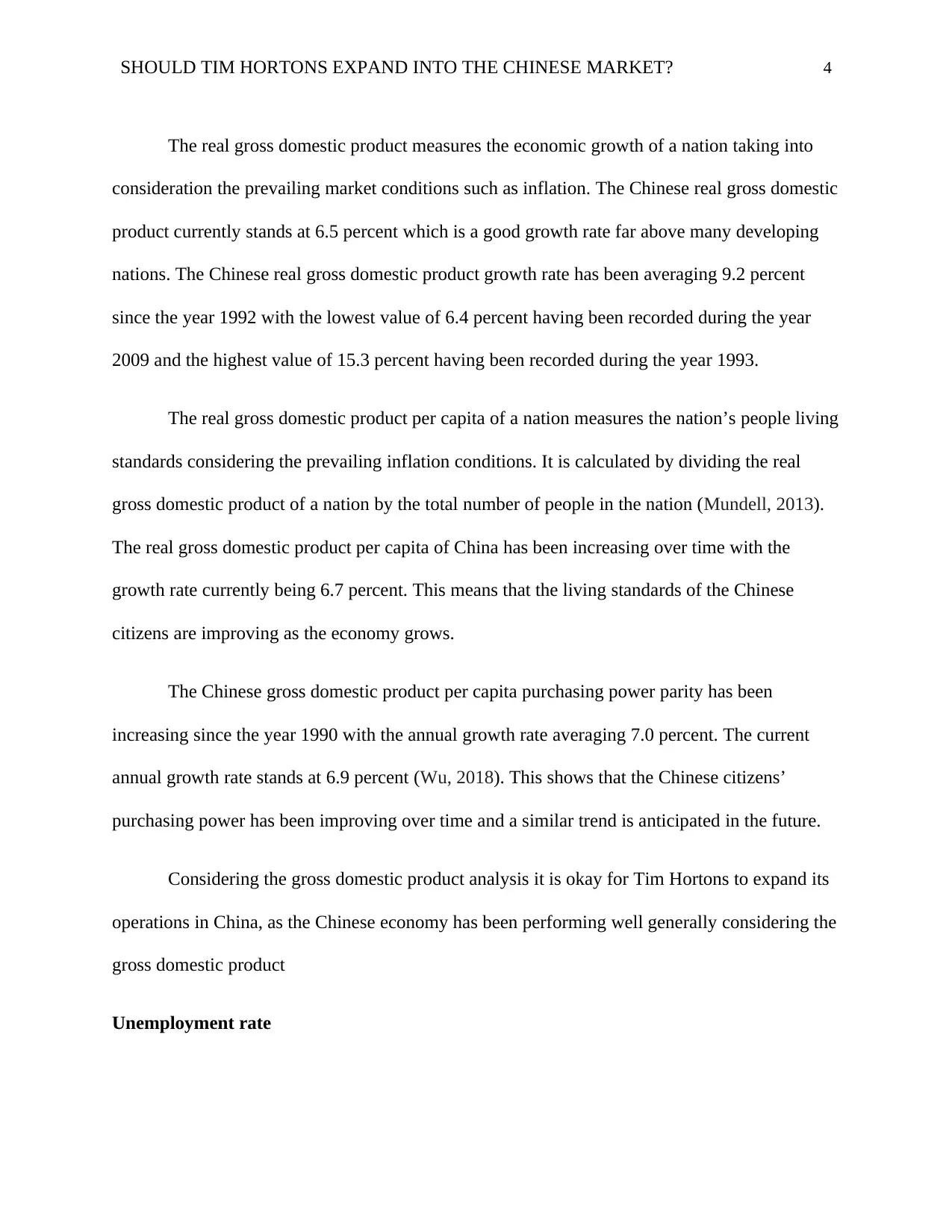
SHOULD TIM HORTONS EXPAND INTO THE CHINESE MARKET? 4
The real gross domestic product measures the economic growth of a nation taking into
consideration the prevailing market conditions such as inflation. The Chinese real gross domestic
product currently stands at 6.5 percent which is a good growth rate far above many developing
nations. The Chinese real gross domestic product growth rate has been averaging 9.2 percent
since the year 1992 with the lowest value of 6.4 percent having been recorded during the year
2009 and the highest value of 15.3 percent having been recorded during the year 1993.
The real gross domestic product per capita of a nation measures the nation’s people living
standards considering the prevailing inflation conditions. It is calculated by dividing the real
gross domestic product of a nation by the total number of people in the nation (Mundell, 2013).
The real gross domestic product per capita of China has been increasing over time with the
growth rate currently being 6.7 percent. This means that the living standards of the Chinese
citizens are improving as the economy grows.
The Chinese gross domestic product per capita purchasing power parity has been
increasing since the year 1990 with the annual growth rate averaging 7.0 percent. The current
annual growth rate stands at 6.9 percent (Wu, 2018). This shows that the Chinese citizens’
purchasing power has been improving over time and a similar trend is anticipated in the future.
Considering the gross domestic product analysis it is okay for Tim Hortons to expand its
operations in China, as the Chinese economy has been performing well generally considering the
gross domestic product
Unemployment rate
The real gross domestic product measures the economic growth of a nation taking into
consideration the prevailing market conditions such as inflation. The Chinese real gross domestic
product currently stands at 6.5 percent which is a good growth rate far above many developing
nations. The Chinese real gross domestic product growth rate has been averaging 9.2 percent
since the year 1992 with the lowest value of 6.4 percent having been recorded during the year
2009 and the highest value of 15.3 percent having been recorded during the year 1993.
The real gross domestic product per capita of a nation measures the nation’s people living
standards considering the prevailing inflation conditions. It is calculated by dividing the real
gross domestic product of a nation by the total number of people in the nation (Mundell, 2013).
The real gross domestic product per capita of China has been increasing over time with the
growth rate currently being 6.7 percent. This means that the living standards of the Chinese
citizens are improving as the economy grows.
The Chinese gross domestic product per capita purchasing power parity has been
increasing since the year 1990 with the annual growth rate averaging 7.0 percent. The current
annual growth rate stands at 6.9 percent (Wu, 2018). This shows that the Chinese citizens’
purchasing power has been improving over time and a similar trend is anticipated in the future.
Considering the gross domestic product analysis it is okay for Tim Hortons to expand its
operations in China, as the Chinese economy has been performing well generally considering the
gross domestic product
Unemployment rate
Paraphrase This Document
Need a fresh take? Get an instant paraphrase of this document with our AI Paraphraser
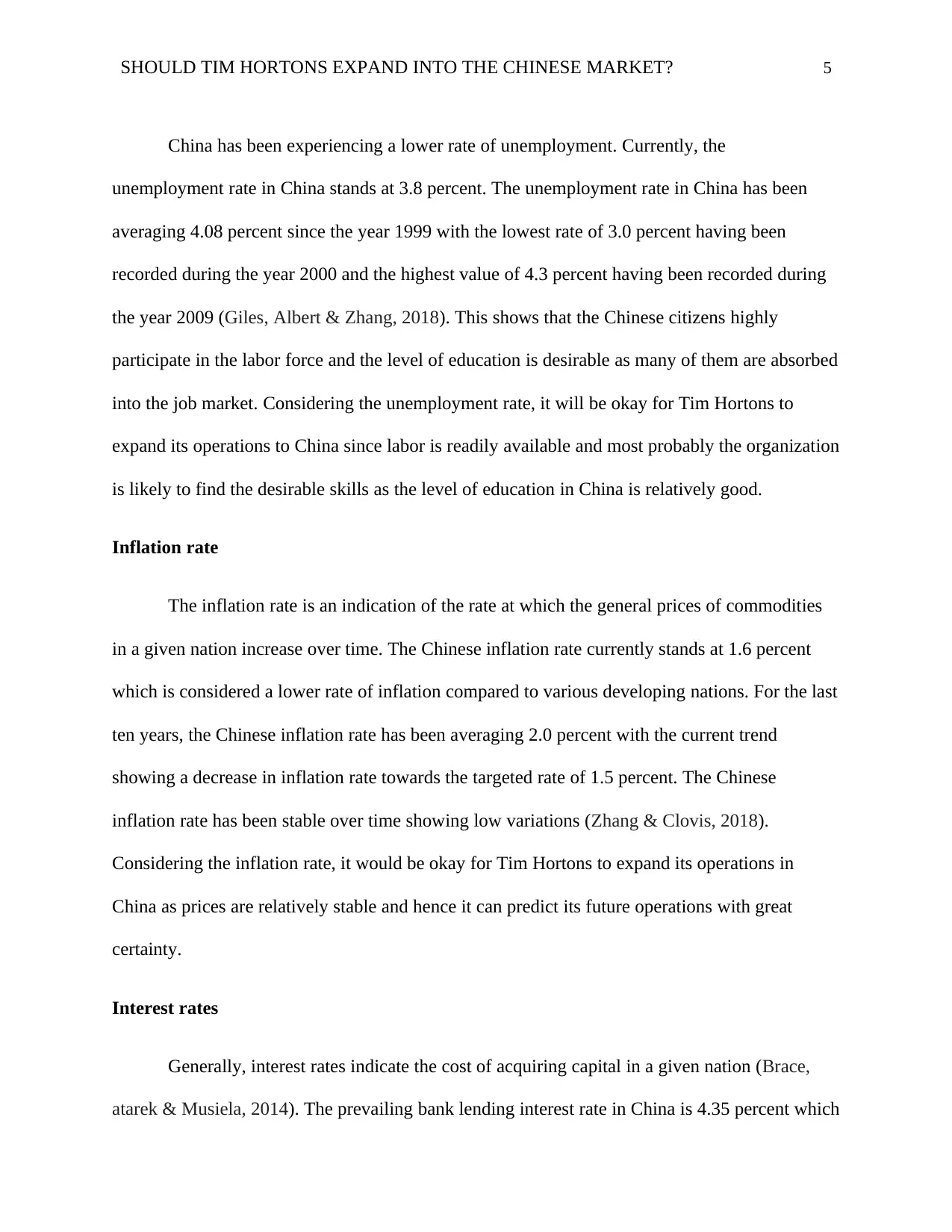
SHOULD TIM HORTONS EXPAND INTO THE CHINESE MARKET? 5
China has been experiencing a lower rate of unemployment. Currently, the
unemployment rate in China stands at 3.8 percent. The unemployment rate in China has been
averaging 4.08 percent since the year 1999 with the lowest rate of 3.0 percent having been
recorded during the year 2000 and the highest value of 4.3 percent having been recorded during
the year 2009 (Giles, Albert & Zhang, 2018). This shows that the Chinese citizens highly
participate in the labor force and the level of education is desirable as many of them are absorbed
into the job market. Considering the unemployment rate, it will be okay for Tim Hortons to
expand its operations to China since labor is readily available and most probably the organization
is likely to find the desirable skills as the level of education in China is relatively good.
Inflation rate
The inflation rate is an indication of the rate at which the general prices of commodities
in a given nation increase over time. The Chinese inflation rate currently stands at 1.6 percent
which is considered a lower rate of inflation compared to various developing nations. For the last
ten years, the Chinese inflation rate has been averaging 2.0 percent with the current trend
showing a decrease in inflation rate towards the targeted rate of 1.5 percent. The Chinese
inflation rate has been stable over time showing low variations (Zhang & Clovis, 2018).
Considering the inflation rate, it would be okay for Tim Hortons to expand its operations in
China as prices are relatively stable and hence it can predict its future operations with great
certainty.
Interest rates
Generally, interest rates indicate the cost of acquiring capital in a given nation (Brace,
atarek & Musiela, 2014). The prevailing bank lending interest rate in China is 4.35 percent which
China has been experiencing a lower rate of unemployment. Currently, the
unemployment rate in China stands at 3.8 percent. The unemployment rate in China has been
averaging 4.08 percent since the year 1999 with the lowest rate of 3.0 percent having been
recorded during the year 2000 and the highest value of 4.3 percent having been recorded during
the year 2009 (Giles, Albert & Zhang, 2018). This shows that the Chinese citizens highly
participate in the labor force and the level of education is desirable as many of them are absorbed
into the job market. Considering the unemployment rate, it will be okay for Tim Hortons to
expand its operations to China since labor is readily available and most probably the organization
is likely to find the desirable skills as the level of education in China is relatively good.
Inflation rate
The inflation rate is an indication of the rate at which the general prices of commodities
in a given nation increase over time. The Chinese inflation rate currently stands at 1.6 percent
which is considered a lower rate of inflation compared to various developing nations. For the last
ten years, the Chinese inflation rate has been averaging 2.0 percent with the current trend
showing a decrease in inflation rate towards the targeted rate of 1.5 percent. The Chinese
inflation rate has been stable over time showing low variations (Zhang & Clovis, 2018).
Considering the inflation rate, it would be okay for Tim Hortons to expand its operations in
China as prices are relatively stable and hence it can predict its future operations with great
certainty.
Interest rates
Generally, interest rates indicate the cost of acquiring capital in a given nation (Brace,
atarek & Musiela, 2014). The prevailing bank lending interest rate in China is 4.35 percent which
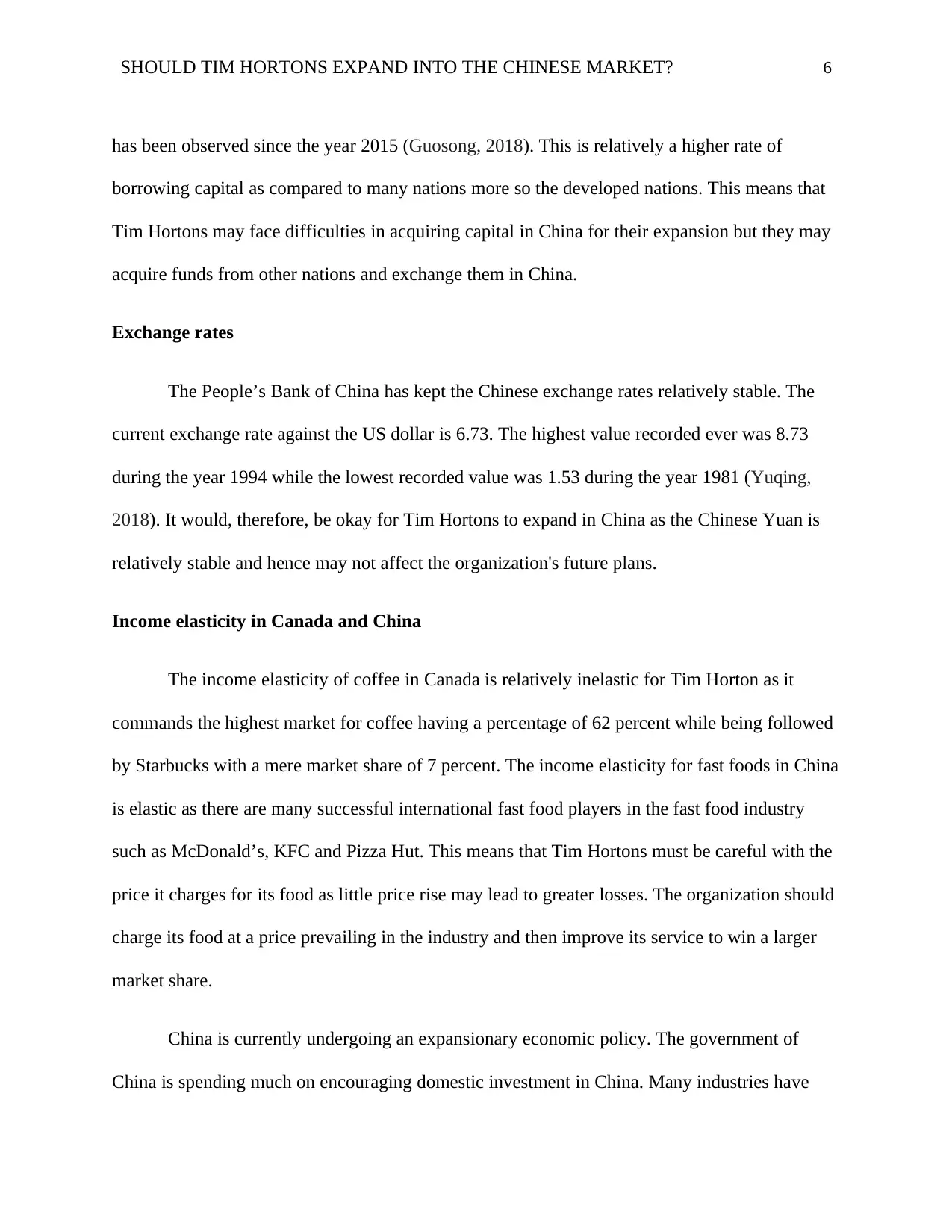
SHOULD TIM HORTONS EXPAND INTO THE CHINESE MARKET? 6
has been observed since the year 2015 (Guosong, 2018). This is relatively a higher rate of
borrowing capital as compared to many nations more so the developed nations. This means that
Tim Hortons may face difficulties in acquiring capital in China for their expansion but they may
acquire funds from other nations and exchange them in China.
Exchange rates
The People’s Bank of China has kept the Chinese exchange rates relatively stable. The
current exchange rate against the US dollar is 6.73. The highest value recorded ever was 8.73
during the year 1994 while the lowest recorded value was 1.53 during the year 1981 (Yuqing,
2018). It would, therefore, be okay for Tim Hortons to expand in China as the Chinese Yuan is
relatively stable and hence may not affect the organization's future plans.
Income elasticity in Canada and China
The income elasticity of coffee in Canada is relatively inelastic for Tim Horton as it
commands the highest market for coffee having a percentage of 62 percent while being followed
by Starbucks with a mere market share of 7 percent. The income elasticity for fast foods in China
is elastic as there are many successful international fast food players in the fast food industry
such as McDonald’s, KFC and Pizza Hut. This means that Tim Hortons must be careful with the
price it charges for its food as little price rise may lead to greater losses. The organization should
charge its food at a price prevailing in the industry and then improve its service to win a larger
market share.
China is currently undergoing an expansionary economic policy. The government of
China is spending much on encouraging domestic investment in China. Many industries have
has been observed since the year 2015 (Guosong, 2018). This is relatively a higher rate of
borrowing capital as compared to many nations more so the developed nations. This means that
Tim Hortons may face difficulties in acquiring capital in China for their expansion but they may
acquire funds from other nations and exchange them in China.
Exchange rates
The People’s Bank of China has kept the Chinese exchange rates relatively stable. The
current exchange rate against the US dollar is 6.73. The highest value recorded ever was 8.73
during the year 1994 while the lowest recorded value was 1.53 during the year 1981 (Yuqing,
2018). It would, therefore, be okay for Tim Hortons to expand in China as the Chinese Yuan is
relatively stable and hence may not affect the organization's future plans.
Income elasticity in Canada and China
The income elasticity of coffee in Canada is relatively inelastic for Tim Horton as it
commands the highest market for coffee having a percentage of 62 percent while being followed
by Starbucks with a mere market share of 7 percent. The income elasticity for fast foods in China
is elastic as there are many successful international fast food players in the fast food industry
such as McDonald’s, KFC and Pizza Hut. This means that Tim Hortons must be careful with the
price it charges for its food as little price rise may lead to greater losses. The organization should
charge its food at a price prevailing in the industry and then improve its service to win a larger
market share.
China is currently undergoing an expansionary economic policy. The government of
China is spending much on encouraging domestic investment in China. Many industries have
⊘ This is a preview!⊘
Do you want full access?
Subscribe today to unlock all pages.

Trusted by 1+ million students worldwide
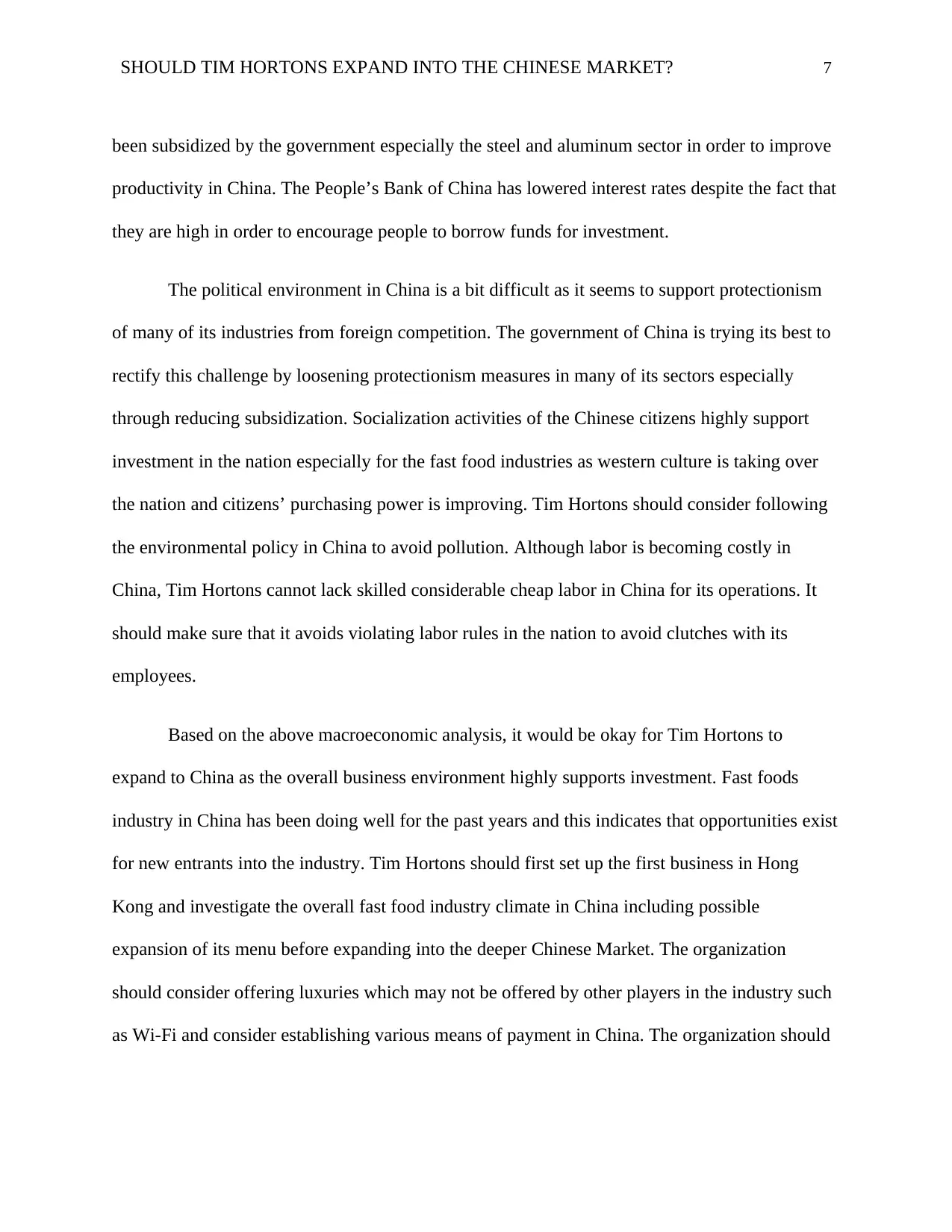
SHOULD TIM HORTONS EXPAND INTO THE CHINESE MARKET? 7
been subsidized by the government especially the steel and aluminum sector in order to improve
productivity in China. The People’s Bank of China has lowered interest rates despite the fact that
they are high in order to encourage people to borrow funds for investment.
The political environment in China is a bit difficult as it seems to support protectionism
of many of its industries from foreign competition. The government of China is trying its best to
rectify this challenge by loosening protectionism measures in many of its sectors especially
through reducing subsidization. Socialization activities of the Chinese citizens highly support
investment in the nation especially for the fast food industries as western culture is taking over
the nation and citizens’ purchasing power is improving. Tim Hortons should consider following
the environmental policy in China to avoid pollution. Although labor is becoming costly in
China, Tim Hortons cannot lack skilled considerable cheap labor in China for its operations. It
should make sure that it avoids violating labor rules in the nation to avoid clutches with its
employees.
Based on the above macroeconomic analysis, it would be okay for Tim Hortons to
expand to China as the overall business environment highly supports investment. Fast foods
industry in China has been doing well for the past years and this indicates that opportunities exist
for new entrants into the industry. Tim Hortons should first set up the first business in Hong
Kong and investigate the overall fast food industry climate in China including possible
expansion of its menu before expanding into the deeper Chinese Market. The organization
should consider offering luxuries which may not be offered by other players in the industry such
as Wi-Fi and consider establishing various means of payment in China. The organization should
been subsidized by the government especially the steel and aluminum sector in order to improve
productivity in China. The People’s Bank of China has lowered interest rates despite the fact that
they are high in order to encourage people to borrow funds for investment.
The political environment in China is a bit difficult as it seems to support protectionism
of many of its industries from foreign competition. The government of China is trying its best to
rectify this challenge by loosening protectionism measures in many of its sectors especially
through reducing subsidization. Socialization activities of the Chinese citizens highly support
investment in the nation especially for the fast food industries as western culture is taking over
the nation and citizens’ purchasing power is improving. Tim Hortons should consider following
the environmental policy in China to avoid pollution. Although labor is becoming costly in
China, Tim Hortons cannot lack skilled considerable cheap labor in China for its operations. It
should make sure that it avoids violating labor rules in the nation to avoid clutches with its
employees.
Based on the above macroeconomic analysis, it would be okay for Tim Hortons to
expand to China as the overall business environment highly supports investment. Fast foods
industry in China has been doing well for the past years and this indicates that opportunities exist
for new entrants into the industry. Tim Hortons should first set up the first business in Hong
Kong and investigate the overall fast food industry climate in China including possible
expansion of its menu before expanding into the deeper Chinese Market. The organization
should consider offering luxuries which may not be offered by other players in the industry such
as Wi-Fi and consider establishing various means of payment in China. The organization should
Paraphrase This Document
Need a fresh take? Get an instant paraphrase of this document with our AI Paraphraser
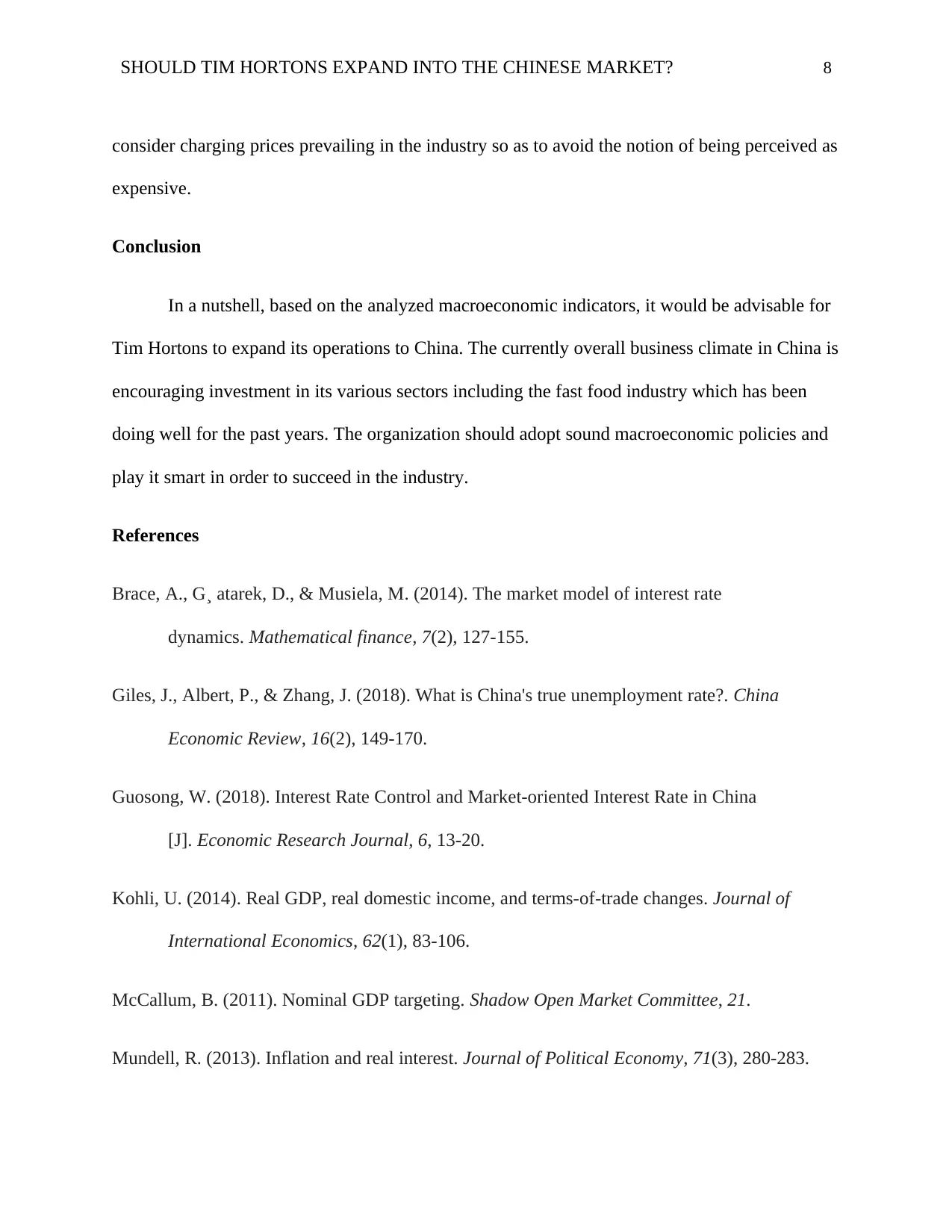
SHOULD TIM HORTONS EXPAND INTO THE CHINESE MARKET? 8
consider charging prices prevailing in the industry so as to avoid the notion of being perceived as
expensive.
Conclusion
In a nutshell, based on the analyzed macroeconomic indicators, it would be advisable for
Tim Hortons to expand its operations to China. The currently overall business climate in China is
encouraging investment in its various sectors including the fast food industry which has been
doing well for the past years. The organization should adopt sound macroeconomic policies and
play it smart in order to succeed in the industry.
References
Brace, A., G¸ atarek, D., & Musiela, M. (2014). The market model of interest rate
dynamics. Mathematical finance, 7(2), 127-155.
Giles, J., Albert, P., & Zhang, J. (2018). What is China's true unemployment rate?. China
Economic Review, 16(2), 149-170.
Guosong, W. (2018). Interest Rate Control and Market-oriented Interest Rate in China
[J]. Economic Research Journal, 6, 13-20.
Kohli, U. (2014). Real GDP, real domestic income, and terms-of-trade changes. Journal of
International Economics, 62(1), 83-106.
McCallum, B. (2011). Nominal GDP targeting. Shadow Open Market Committee, 21.
Mundell, R. (2013). Inflation and real interest. Journal of Political Economy, 71(3), 280-283.
consider charging prices prevailing in the industry so as to avoid the notion of being perceived as
expensive.
Conclusion
In a nutshell, based on the analyzed macroeconomic indicators, it would be advisable for
Tim Hortons to expand its operations to China. The currently overall business climate in China is
encouraging investment in its various sectors including the fast food industry which has been
doing well for the past years. The organization should adopt sound macroeconomic policies and
play it smart in order to succeed in the industry.
References
Brace, A., G¸ atarek, D., & Musiela, M. (2014). The market model of interest rate
dynamics. Mathematical finance, 7(2), 127-155.
Giles, J., Albert, P., & Zhang, J. (2018). What is China's true unemployment rate?. China
Economic Review, 16(2), 149-170.
Guosong, W. (2018). Interest Rate Control and Market-oriented Interest Rate in China
[J]. Economic Research Journal, 6, 13-20.
Kohli, U. (2014). Real GDP, real domestic income, and terms-of-trade changes. Journal of
International Economics, 62(1), 83-106.
McCallum, B. (2011). Nominal GDP targeting. Shadow Open Market Committee, 21.
Mundell, R. (2013). Inflation and real interest. Journal of Political Economy, 71(3), 280-283.
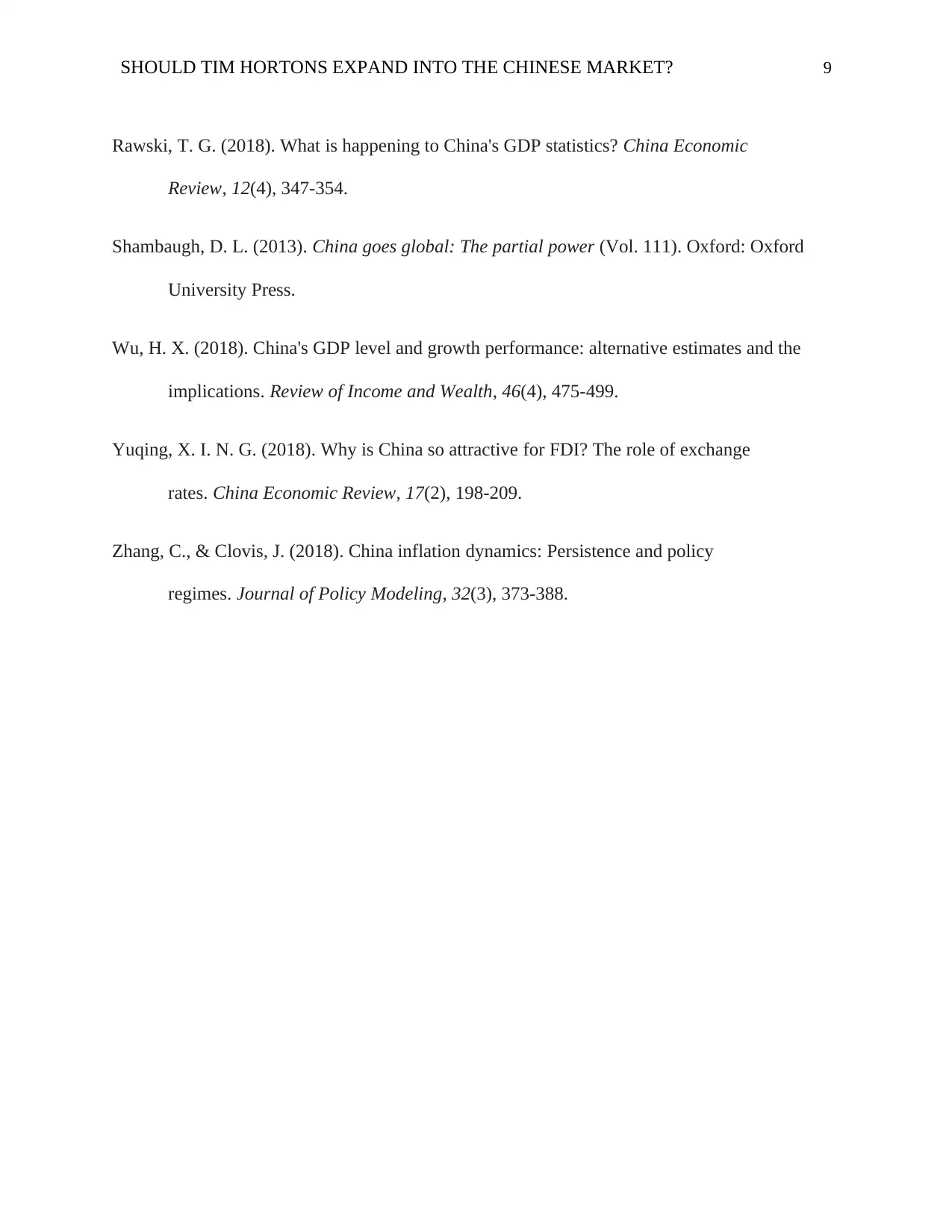
SHOULD TIM HORTONS EXPAND INTO THE CHINESE MARKET? 9
Rawski, T. G. (2018). What is happening to China's GDP statistics? China Economic
Review, 12(4), 347-354.
Shambaugh, D. L. (2013). China goes global: The partial power (Vol. 111). Oxford: Oxford
University Press.
Wu, H. X. (2018). China's GDP level and growth performance: alternative estimates and the
implications. Review of Income and Wealth, 46(4), 475-499.
Yuqing, X. I. N. G. (2018). Why is China so attractive for FDI? The role of exchange
rates. China Economic Review, 17(2), 198-209.
Zhang, C., & Clovis, J. (2018). China inflation dynamics: Persistence and policy
regimes. Journal of Policy Modeling, 32(3), 373-388.
Rawski, T. G. (2018). What is happening to China's GDP statistics? China Economic
Review, 12(4), 347-354.
Shambaugh, D. L. (2013). China goes global: The partial power (Vol. 111). Oxford: Oxford
University Press.
Wu, H. X. (2018). China's GDP level and growth performance: alternative estimates and the
implications. Review of Income and Wealth, 46(4), 475-499.
Yuqing, X. I. N. G. (2018). Why is China so attractive for FDI? The role of exchange
rates. China Economic Review, 17(2), 198-209.
Zhang, C., & Clovis, J. (2018). China inflation dynamics: Persistence and policy
regimes. Journal of Policy Modeling, 32(3), 373-388.
⊘ This is a preview!⊘
Do you want full access?
Subscribe today to unlock all pages.

Trusted by 1+ million students worldwide
1 out of 9
Related Documents
Your All-in-One AI-Powered Toolkit for Academic Success.
+13062052269
info@desklib.com
Available 24*7 on WhatsApp / Email
![[object Object]](/_next/static/media/star-bottom.7253800d.svg)
Unlock your academic potential
Copyright © 2020–2025 A2Z Services. All Rights Reserved. Developed and managed by ZUCOL.





